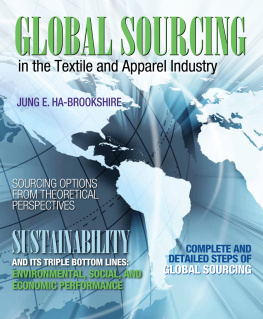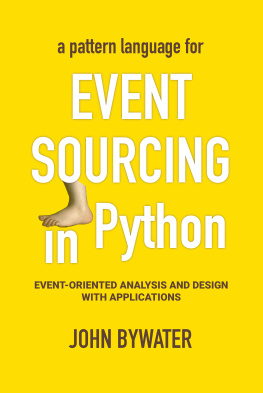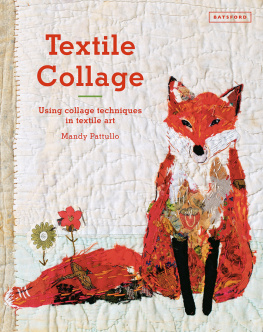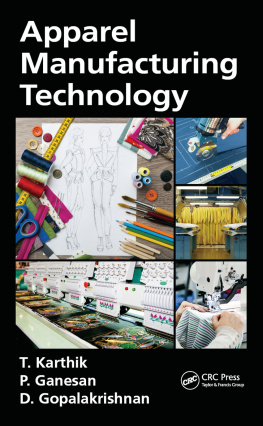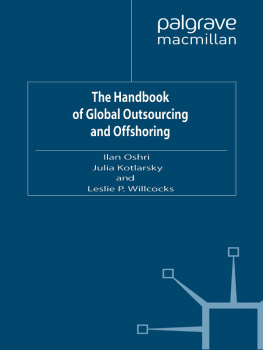
Global Sourcing in the Textile and Apparel Industry
Jung E. Ha-Brookshire, Ph.D.
University of Missouri

BostonColumbusIndianapolisNew YorkSan FranciscoUpper Saddle River AmsterdamCape TownDubaiLondonMadridMilanMunichParisMontrealToronto DelhiMexico CitySao PauloSydneyHong KongSeoulSingaporeTaipeiTokyo
Editorial Director: Vernon Anthony
Acquisitions Editor: Lindsey Gill
Editorial Assistant: Nancy Kesterson
Director of Marketing: David Gesell
Senior Marketing Coordinator: Alicia Wozniak
Program Manager: Laura J. Weaver
Project Manager: Janet Portisch
Procurement Specialist: Deidra Skahill
Manager, Rights and Permissions: Mike Lackey
Art Director: Jayne Conte
Cover Designer: Karen Salzbach
Cover Image: Fotolia
Media Director: Leslie Brado
Lead Media Project Manager: April Cleland
Full-Service Project Management: Thistle Hill Publishing Services
Composition: Cenveo Publisher Services
Cover Printer: Lehigh-Phoenix Color/Hagerstown
Text Printer: Courier/Kendallville
Text Font: 9/15 Helvetica Neue
Credits and acknowledgments for materials borrowed from other sources and reproduced, with permission, in this textbook appear on the appropriate page within the text. Unless otherwise stated, all artwork has been provided by the author.
Copyright 2015 Pearson Education, Inc., publishing as Prentice Hall, One Lake Street, Upper Saddle River, New Jersey, 07458. All rights reserved. Manufactured in the United States of America. This publication is protected by Copyright, and permission should be obtained from the publisher prior to any prohibited reproduction, storage in a retrieval system, or transmission in any form or by any means, electronic, mechanical, photocopying, recording, or likewise. To obtain permission(s) to use material from this work, please submit a written request to Pearson Education, Inc., Permissions Department, One Lake Street, Upper Saddle River, New Jersey, 07458, or you may fax your request to 201-236-3290.
Many of the designations by manufacturers and seller to distinguish their products are claimed as trademarks. Where those designations appear in this book, and the publisher was aware of a trademark claim, the designations have been printed in initial caps or all caps.
Library of Congress Cataloging-in-Publication Data
Ha-Brookshire, Jung.
Global sourcing in the textile and apparel industry/Jung E. Ha-Brookshire,
University of Missouri. pages cm
Includes bibliographical references and index.
ISBN-13: 978-0-13-297462-2 (pbk.)
ISBN-10: 0-13-297462-2 (pbk.)
1. Textile industry. 2. Clothing trade. 3. Business logistics. 4. Imports.
5. Globalization. I. Title.
HD9850.5.H3 2015
677.00687dc23
2013043928
10 9 8 7 6 5 4 3 2 1

ISBN 10: 0-13-297462-2
ISBN 13: 978-0-13-297462-2
Brief Contents
Contents
Preface
U.S. textile and apparel businesses have engaged in global sourcing for more than six decades. I have been fortunate to be involved in global sourcing both directly and indirectly. I was born and raised in Daegu, South Korea. During my early childhood in the 1970s, the town of Daegu experienced rapid growth through its thriving textile mills and apparel manufacturing plants. DuPont, a U.S. textile manufacturing company, set up one of the largest textile and apparel manufacturing plants in my town. It was the first company where one of my aunts was able to get her very first job. Back then, women were less likely to have education or a career in my country. The fact that she woke up every morning, wore a uniform, went to work, and studied at DuPonts after-work school programs was so novel that the whole town was concerned about my brave aunts future. She was too modern! I loved watching her going to work and school, and every year on Childrens Day, May 5 (to most of us Korean children this national holiday celebrating children was more exciting than Christmas), she took me to the DuPont campus where I saw green grass for the first time. I thought DuPont was the best thing ever to happen to us and our town.
Since then I have wanted to be involved in global sourcing. At that time I had no concept of global sourcing. However, I knew what I wanted to do when I grew up. I wanted to travel all over the world, establish a factory (or find one), then throw annual Childrens Day parties in lots of different countries. Twenty years later, after earning a bachelors degree in clothing and textiles from Seoul National University, I flew to New York City looking for an opportunity to start accomplishing my childhood dream. Within a few months, I found my very first job as a production assistant at Popsicle Playwear, a division of Adjmi Apparel Group, on 33rd Street near Macys. I was quickly promoted and became fully engaged in global sourcing. All of my companys product portfolios were sourced from foreign countries such as China, Taiwan, Hong Kong, Indonesia, Turkey, United Arab Emirates, Pakistan, and even South Korea. By 2000, my team was sourcing and importing over $100 million worth of goods from all over the world.
The success of my career at Adjmi Apparel Group helped me land a job at Richard Leeds International, Inc., whose specialty was sleepwear. From 2001 to 2004, I was responsible for Central American production, sourcing and importing up to $10 million at wholesale value. Sourcing from the Central American region had whole new sets of challenges and questions. I had to learn everything from the ground up by doing the job. While working at these jobs, I somehow managed to throw several birthday parties for factory workers, played with their children, and participated in their night school activities. Indeed, my childhood dream came true. People whom I worked with all over the world were extremely motivated, eager to learn and wanting to be an active part of the global economy.
Although my colleagues in these developing countries were eager to learn, at home in New York City I had become more and more frustrated with the lack of basic knowledge and skill sets from college graduates whom I interviewed for one of my staff positions. I found it extremely difficult to find college graduates with a decent level of understanding of international business, global trades, and global sourcing. Both then and today I question why college graduates do not have an adequate understanding of global sourcing when the majority of U.S. businesses are engaged in global sourcing. When I returned to academics, I found that there were no comprehensive, viable, up-to-date instructional materials available for global sourcing. Rather, global sourcing was deemed to be mysterious and too difficult to learn about in a classroom.
The ideas for this book were conceived in 2007, when I took an assistant professor position at the University of Missouri. I wanted to produce a textbook that had real-life implications while maintaining theoretical perspectives. I searched and gathered all the reference materials and information through personal contacts, library search, and literature from governments, laws, trades, and businesses. For the first class that I taught on global sourcing in 2008, I compiled all these materials into a reference book. Then I personalized the lectures with many of my business experiences so that students could better understand the concepts in the textile and apparel industry. My students loved the class. By 2009 my lectures were translated into PowerPoint slides and by 2010 they were audio-recorded. In 2011 and 2012 I began writing this textbookthe result of eight years of experience working in global sourcing and researching the subject, and six years of teaching experience related to global sourcing.
Next page
